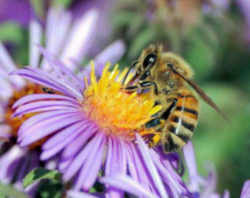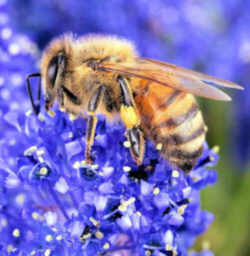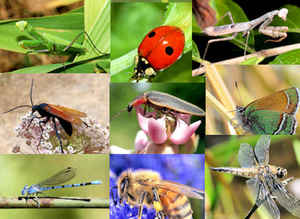
Oklahoma Symbols
Oklahoma State Insect
Honeybee

(Apis mellifera)
Adopted on May 14, 1992.
The Honeybee, (Apis mellifera,) was adopted as Oklahoma's state insect on May 14,1992. One of the most familiar insects in the world is the Honeybee. This member of the insect order Hymenoptera plays a key role in the human and natural world. More has been written about honeybees than any other species of insect.
Did you know that: The honey bee has been proclaimed the official state insect in each of the following states:
Arkansas | Georgia | Kansas
| Kentucky | Louisiana
Maine | Mississippi |
Missouri | Nebraska | New Jersey
North Carolina | Oklahoma | South
Dakota | Tennessee
Utah | Vermont | West Virginia
| Wisconsin
Oklahoma State Insect: Honeybee
Honey Bees are not native to the Americas. During the 1600's settlers brought honey bee colonies with them from Europe, hence the name European Honey Bees(EHB).
- Produce about 4 million pounds of Beeswax
- Produce bee pollen, bee venom, royal jelly, etc
- Pollinate greater than 90 cultivated crops with an Estimate value of $20 billion
- Contribution from pollination effects every third bite of food consumed

The honeybee is one of the many European
imports to the New World. In 1992 is the 500th anniversary of Columbus' voyage, which is a reminder of the many exchanges between the old and new worlds.
The honeybee is critical to crop pollination and plays a vital role in our varied and plentiful food supply and during World War II, honey was an essential
staple for American households and beeswax was a vital component of machine lubricants for the military and the State Department of Agriculture reports
there are 1,200 beekeepers with 9,000 colonies in this state producing an estimated 50 pound of honey per colony annually and the yearly value of honey
production is estimated at $365,000.00 in the State of Oklahoma and the honeybee industry serves as a vocation and avocation for Oklahoma producers.
The honeybee plays a vital economic role in Oklahoma through its pollination of various crops, trees, and grasses. The honeybee is the only insect that can be moved for the express purpose of pollination.
Bees produce honey as food stores for the hive during the long months of winter when flowers aren't blooming and therefore little or no nectar is available to them. European honey bees, genus Apis Mellifera, produce such an abundance of honey, far more than the hive can eat, that humans can harvest the excess. For this reason, European honey bees can be found in beekeeper's hives around the world!
The taste, color and nutrient content of honey varies from place to place depending upon the kind of flora growing in the area. For example, Tupelo honey (from Tennessee) is twice as sweet as most honey. Many people take honey from their own neighborhood as a kind of natural antihistamine.
Honeybees probably originated in Tropical Africa and spread from South Africa to Northern Europe and East into India and China. They were brought to the Americas with the first colonists and are now distributed world-wide. The first bees appear in the fossil record in deposits dating about 40 million years ago in the Eocene. At about 30 million years before present they appear to have developed social behavior and structurally are virtually identical with modern bees.
Characteristics of the Oklahoma Honeybee
Colony:
Honey bees are social insects, with a marked division of labor between the various types of bees in the colony. A colony of honey bees includes a queen, drones and workers. A typical small hive contains perhaps 20,000 bees and these are divided into three types: Queen, Drone, and Worker. The bee has eyes for seeing flowers, antennae for detecting fragrances, wing muscles for flight, legs for walking and pollen gathering, a crop for transporting nectar, and a stinger for defense of the hive.
The Queen:
The queen is the only sexually developed female in the hive. She is the largest bee in the colony.
A two-day-old larva is selected by the workers to be reared as the queen. She will emerge from her cell 11 days later to mate in flight with approximately
18 drone (male) bees. During this mating, she receives several million sperm cells, which last her entire life span of nearly two years.
The queen starts to lay eggs about 10 days after mating. A productive queen can lay 3,000 eggs in a single day.
The Drones:
Drones are stout male bees that have no stingers. Drones do not collect food or pollen from flowers. Their sole purpose is to mate with the queen. If the colony is short on food, drones are often kicked out of the hive.
The Workers:
Workers, the smallest bees in the colony, are sexually undeveloped females. A colony can have 50,000 to 60,000 workers.
The life span of a worker bee varies according to the time of year. Her life expectancy is approximately 28 to 35 days. Workers that are reared in
September and October, however, can live through the winter.
Workers feed the queen and larvae, guard the hive entrance and help to keep the hive cool by fanning their wings. Worker bees also collect nectar to
make honey. In addition, honey bees produce wax comb. The comb is composed of hexagonal cells which have walls that are only 2/1000 inch thick, but
support 25 times their own weight.
Honey bees' wings stroke 11,400 times per minute, thus making their distinctive buzz.
Oklahoma Senate Resolution
Senate Concurrent Resolution No. 75
A Concurrent Resolution declaring the honeybee (apis mellifera)
the official insect of the State of Oklahoma;
and directing distribution.
WHEREAS, apis mellifera, commonly referred to as the honeybee, is one of the many European imports to the New World; and
WHEREAS, 1992 is the 500th anniversary of Columbus' voyage, which is a reminder of the many exchanges between the old and new worlds; and
WHEREAS, the honeybee is critical to crop pollination and plays a vital role in our varied and plentiful food supply; and
WHEREAS, during World War II, honey was an essential staple for American households and beeswax was a vital component of machine lubricants for the
military; and
WHEREAS, the State Department of Agriculture reports there are 1,200 beekeepers with 9,000 colonies in this state producing an estimated 50 pound of
honey per colony annually; and
WHEREAS, the yearly value of honey production is estimated at $365,000.00 in the State of Oklahoma; and
WHEREAS, the honeybee industry serves as a vocation and avocation for Oklahoma producers.
Now, Therefore, be it resolved by the Senate of the 2nd Session of the 43rd Oklahoma Legislature, the House of Representatives concurring therein:
THAT apis mellifera, commonly known as the honeybee, is hereby declared the Official Insect of the State of Oklahoma.
THAT a copy of this resolution be forwarded to the Governor and the Oklahoma Secretary of Agriculture.
Adopted by the Senate the 21st day of April, 1992.
Adopted by the House of Representatives the 13th day of May, 1992.
Filed with the Secretary of State May 14, 1992.
Taxonomic Hierarchy: Western Honey Bee
Kingdom: Animalia (Animals)
Phylum: Arthropoda (Arthropods)
Subphylum: Hexapoda (Hexapods)
Class: Insecta (Insects)
Order: Hymenoptera (Ants, Bees, Wasps and Sawflies)
No Taxon: (Aculeata - Ants, Bees and Stinging Wasps)
No Taxon: (Anthophila (Apoidea) - Bees)
Family: Apidae (Cuckoo, Carpenter, Digger, Bumble, and Honey Bees)
Subfamily: Apinae (Honey, Bumble, Long-horned, Orchid, and Digger Bees)
Tribe: Apini (Honey Bees)
Genus; Apis
Species: mellifera (Western Honey Bee)
Butterflies, and Bugs







